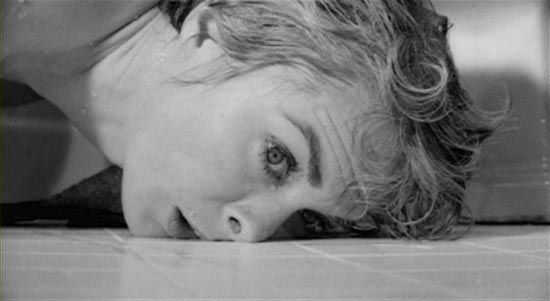What Janet Leigh does with her body in Psycho is not nearly as interesting as what she does with her face. In a very black sense, Hitchcock acknowledges this by destroying her body and leaving us with that lovely face smeared against the bathroom floor. When Marion and Norman talk in her room, Norman walks over to and past Marion and she turns towards him as he passes her. It is as though they are going to dance. As he passes and she turns, she smiles to herself at his ineptitude--he cannot bring himself to say "bathroom" in front of her--and as she looks up the private grin segues into, not a look, more a regard. It is as if for all his ineptitude, his strangeness, she is actually beginning to like this boy. Her look momentarily opens her tired face to new possibilities.
 | Marion smiles when Norman can't bring himself to say "bathroom" while showing her Room #1 at the Bates Motel.
[WITH AUDIO CLIP]
[click photo for multiple photos from this scene] |
In this brief moment, she renews her habitually positive pact with experience, she bounces back as she has a million times before. Emboldened as much as we are charmed, Norman invites Marion to have something to eat with him. Her look is such that we do not notice the cut to him as he issues the invitation, with its mute intimation of disconnection, alienation, horror. The scene is then swallowed up in Perkins' boyish glee that this dreamboat is actually prepared to break bread with him. It feels as though the modern stray who has dominated the first half of the film now "throws" the initiative, the narrative, his way and he's thrilled. "She is so clearly like the all-American girl you saw on the magazine covers," Harvey writes, "in the cigarette ads, even the movies--like Janet Leigh, to put it plainly--the ideal daughter, the ideal wife." And now she is his.
But if we are tempted by what Leigh herself has called "their strange kind of love scene" to think that this could be a couple, that communion is savagely ended by the knife plunging into Marion as she showers. If we are momentarily, blissfully, alone with Marion's thoughts under the showerhead, the next moment we become voyeurs enraged by her body's fleshy lure, the obviousness of the American girl's sex. This collision of moods is of course reiterated whenever the film is shown, resonating appallingly across the culture. Everyone knows it is coming. But it still comes as a shock. When her assailant rips the shower curtain aside, we imperceptibly, fatally, enter his scopic field, his mind set, and (whether we care to admit it or not) collude by seeking glimpses of the woman's body amid her gasps and groans. As Hitchcock commentator Donald Spoto wrote in The Art of Alfred Hitchcock (1992): "Psycho is a film that really takes place in the mind of the viewer." When Marion's hand clutches the shower curtain as she dies, the figural interlude, excessive in more ways than one, ends and we, reeling, surface to confront its awful narrative consequence, recalling how earlier she clutched at her elbow, agitated as she overstepped the mark by suggesting to Norman that his mother be institutionalized.
 | Marion suggests to Norman that maybe his mother should be institutionalized.
[WITH AUDIO CLIP]
[click photo for multiple photos from this scene] |
In her short tenure on screen, Leigh's face runs the gamut from contented to perplexed, sad to sympathetic, worried to agonized. It is the expressive lexicon of a million working girls as they negotiate the troubled terrain of contemporary sex and manners, the life (and death) of the American Girl. If Welles was more interested in Hank Quinlan's moral decline than in what was happening to Susie in that motel cabin, Hitchcock voices the impotence of a million men in the audience. Writing in his Durgnat review, Thomson says: "I think he was an authentic victim of the voyeurist thrust, not just in love with his heroines and his way of looking but alienated from most ways of life known as normal and ordinary." Psycho gave rise to a strand of American horror movie which made the horror as literal as the substantial flesh of its victim, even while this "slasher movie," the generic tag echoing the downward thrust of Norman's knife, also parodies the excessiveness of Marion's slaughter. While generations had watched agog as the heroine melted into the hero's arms in movie after movie, there were always those who wanted the heroine in ways the Production Code could not allow, even as the sweater girl knowingly tantalized the desirous. Cheaply shot in black-and-white beyond the remit of "prestige," sporting the predilection for experiment that has been the prerogative of the grind house, and parading the sweater girl through streets after bedtime, Touch of Evil and Psycho gave the quiet ones in the crowd the soft yielding pleasure for which they searched many a standard studio vehicle.
Few icons have appeared as fleetingly as Janet Leigh did in Psycho. The film itself never really gets over her loss. On the case of the British video there is a still of Marion screaming in the shower, her pearl-white teeth and hint of brunette in the eyebrows the only remaining clues that the girl entreating Van Johnson in The Romance of Rosy Ridge was the same Janet Leigh. It is also somehow appropriate that subsequent Leigh films--The Manchurian Candidate (1962), Telethon (1977), The Fog (1980)--seem anticlimactic, a career in half life.
I would like to thank Dr Warwick Mules of Central Queensland University and writer Adrian Martin for sharing their thoughts on figurality in the cinema with me.

